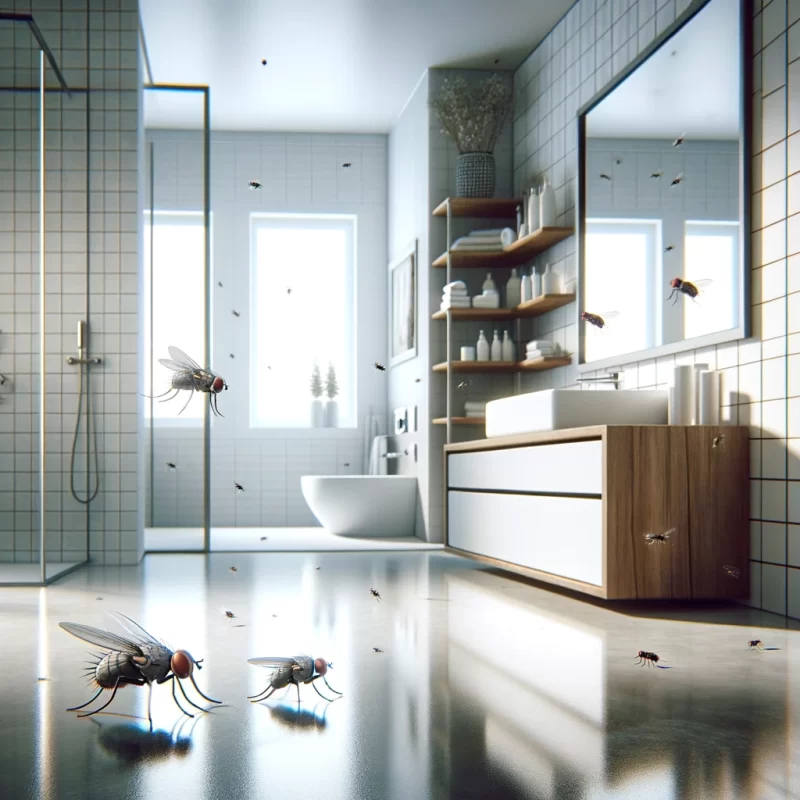Fruit Fly DIY Guides
How to Get Rid of Fruit Flies in Bathroom?
Fruit flies in the bathroom can be a perplexing and frustrating issue. Unlike the kitchen, where food sources are abundant, the bathroom does not typically host fruit bowls or overripe fruit. Yet, the presence of fruit flies or, in some cases, drain or sewer flies, indicates an underlying issue tied to moisture and organic material. This article delves into understanding the cause of fruit fly infestations in bathrooms, distinguishing between fruit flies and drain flies, and providing a comprehensive guide on how to rid your bathroom of these pests through prevention and control measures.
Key Takeaways:
- Bathrooms attract fruit flies due to moisture and organic material in drains, not just from food sources like kitchens.
- Homemade traps, such as those made with vinegar, dish soap, or wine, can effectively capture and control fruit fly populations.
- Regular cleaning and maintenance of drains and moist areas are essential in preventing fruit fly breeding and infestation.
- Prevention is key; reducing moisture through proper towel hygiene and using dehumidifiers can deter fruit flies from settling in bathrooms.
- Addressing the problem early with a combination of DIY solutions and store-bought products can prevent a minor issue from becoming a major infestation.
Understanding the Issue
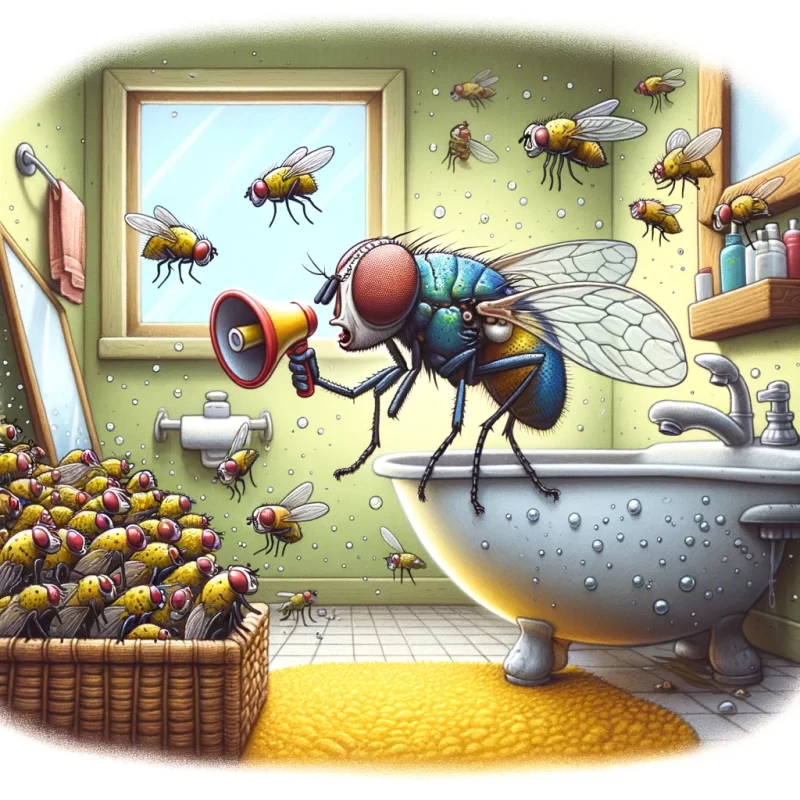
Fruit flies (Drosophila melanogaster) and drain flies (also known as sewer flies or sewer gnats) are small, but they can quickly become a significant nuisance. Female fruit flies are capable of laying hundreds of eggs, and in the warmth and moisture of a bathroom, these eggs can hatch into larvae within 24-30 hours, rapidly increasing the fruit fly population. What attracts them? Fruit flies love moisture and organic matter, which are in abundance in bathroom drains, moist towels, and any standing water.
Drain flies, although often confused with fruit flies, thrive in similar environments but are more closely associated with decaying organic material in sink drains, shower drains, and toilets. Identifying the type of fly infestation you have is crucial because it helps tailor the control efforts more effectively.
Simple Steps to Get Rid of Fruit Flies
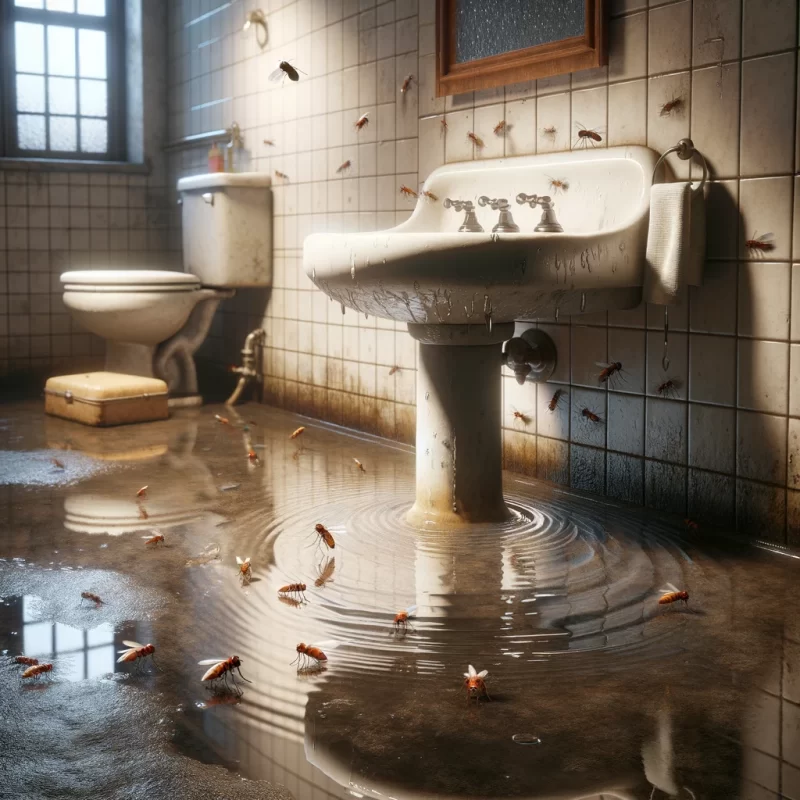
Identify and Eliminate Breeding Grounds
Inspect your bathroom for the common breeding grounds of fruit flies and drain flies. Check for any standing water, moist places, and organic material buildup in bathroom drains, where these pests are known to lay eggs. These are the perfect breeding grounds for flies. Regularly cleaning sink drains and shower drains with a drain cleaner helps remove the organic material where fruit flies and drain flies lay eggs. For a natural solution, pouring boiling water down the drains can also help eliminate larvae and organic residue, further disrupting the cycle of infestation by targeting the areas where they lay eggs.
Create Homemade Fruit Fly Traps
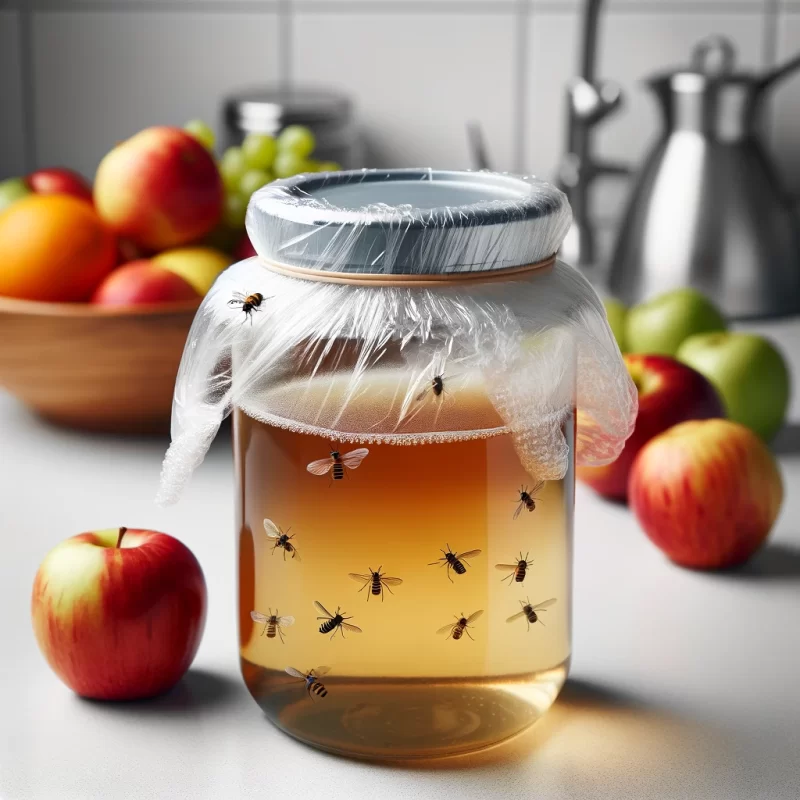
Homemade traps are a cost-effective and eco-friendly way to manage fruit fly populations. Here are some of the most common and effective homemade traps:
- Vinegar and Dish Soap Trap: Mix apple cider vinegar with a few drops of dish soap in a bowl to make a simple homemade fruit fly trap. Cover with plastic wrap and poke small holes. The vinegar attracts the fruit flies, and the dish soap traps them. A disposable cup would also work.
- Wine or Beer Trap: Similar to the vinegar trap, use wine or beer instead. Fruit flies are attracted to the fermenting smell of alcohol. Cover the container with plastic wrap and poke holes. Then, wrap with a rubber band.
- Banana Peel Trap: Place a piece of banana peel in a jar and cover it with plastic wrap. Make a few holes in the wrap. The scent of banana will attract fruit flies, and they’ll get trapped inside.
- Yeast Trap: Mix a small amount of yeast with sugar and water in a bottle. Cover the opening with plastic wrap and poke holes. The fermentation smell attracts fruit flies.
- Milk, Sugar, and Pepper Trap: Boil milk, sugar, and ground pepper, let it cool, then pour into a dish. The mixture attracts fruit flies, and they drown in it.
These traps leverage the natural attraction of fruit flies to fermenting or sweet substances and provide an easy method to capture and eliminate them from your bathroom or kitchen. Regular use of these traps can significantly reduce the population, effectively dealing with any remaining flies that continue to pose a nuisance. Certain essential oils can also keep fruit flies away.
Prevent Future Infestations
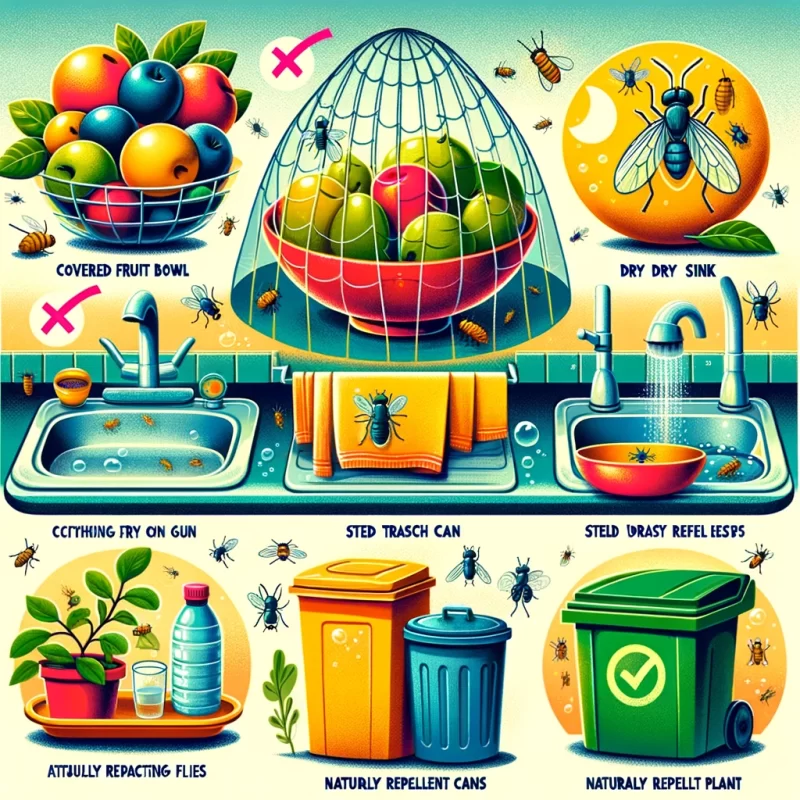
Preventing fruit flies involves reducing the factors that attract them in the first place. Ensure your bathroom is free of moist towels by hanging them to dry immediately after use. Regularly inspect and clean bathroom drains to prevent organic material buildup. Avoid leaving dirty dishes in the sink, and ensure all food remnants are disposed of properly. For fruit and vegetables in the kitchen, use fruit bowls that allow air circulation to avoid creating a food source for fruit flies.
Use Drain Cleaners Regularly
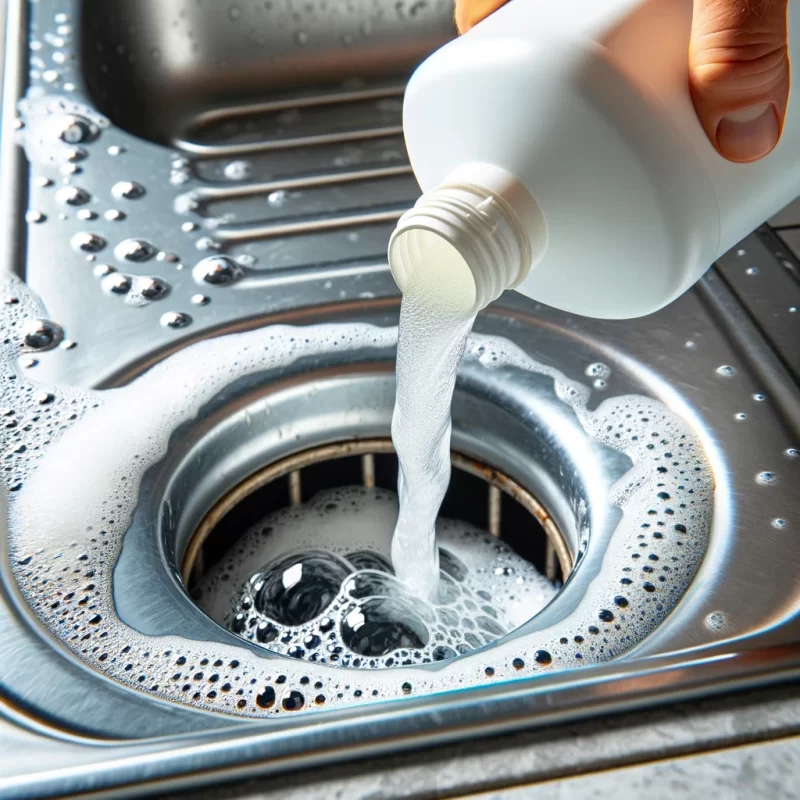
For drain flies, or sewer gnats, regular use of drain cleaners can help control the population by removing the organic matter that larvae feed on. There are both chemical and natural drain cleaner options available. For a natural approach, a mixture of baking soda and vinegar followed by boiling water can help clear the drains of organic debris. Implementing this cleaning routine not only targets drain flies but also serves as an effective measure to prevent fruit flies by eliminating potential breeding sites.
Consider Store-Bought Options
If homemade traps and cleaning efforts do not suffice, there are store-bought options available for controlling fruit fly and drain fly populations. These include sticky traps, chemical sprays, and electric insect zappers. However, it’s important to use these products according to the manufacturer’s instructions and consider the safety of household members and pets.
Addressing Other Issues
Maintaining a Dry and Clean Environment

High humidity and standing water are not only breeding grounds for fruit flies but also attract a variety of other pests, including mosquitoes, cockroaches, and mold. It’s crucial to maintain a dry and clean environment in the bathroom to prevent these issues. Regularly check for leaks around the toilet, sink, and bathtub or shower. Even a small drip can create enough moisture to attract fruit flies and other insects. Fixing these leaks promptly can significantly reduce pest attraction.
Using a dehumidifier can also be an effective way to control moisture levels in the bathroom, especially in climates where humidity is high year-round. Ventilation plays a critical role in moisture control as well. Ensure that your bathroom is well-ventilated by using exhaust fans during and after showers or baths to help remove steam and moisture from the air.
Ensure Cleanliness and Hygiene
In addition to moisture control, maintaining cleanliness and hygiene in the bathroom is vital in preventing a fruit fly infestation. Regular cleaning of surfaces, including floors, walls, and countertops, can remove any residual organic matter that might attract fruit flies. Pay special attention to areas around and under the sink, toilet, and bathtub or shower, as these are common places for organic matter to accumulate.
It’s also advisable to regularly clean bathroom mats, shower curtains, and window sills, as these can harbor moisture and organic residues. Keeping the bathroom tidy and free of clutter can reduce hiding spots for fruit flies and other pests, making it easier to maintain a pest-free environment.
Routine Checks for Early Detection

Regular inspection of your bathroom for signs of fruit flies, drain flies, or other pests can help with early detection and prevention of infestations. Look out for adult flies, larvae, or the more subtle signs such as unusual odors coming from drains, which could indicate a buildup of organic material.
Implementing routine maintenance of bathroom drains and fixtures can prevent the conditions that attract fruit flies. Use natural or chemical drain cleaners regularly to keep drains clear of organic debris. For households with septic systems, ensure that the system is checked and pumped at intervals recommended by professionals, as septic tank issues can also attract fruit flies and other pests.
Conclusion
Getting rid of fruit flies in the bathroom requires a multifaceted approach that includes identifying and eliminating breeding grounds, creating effective traps, and taking preventive measures to avoid future infestations. When you first notice fruit flies, it’s critical to act swiftly to prevent a minor annoyance from escalating into a full-blown fruit fly infestation. Utilizing homemade or store-bought traps can effectively kill fruit flies, significantly reducing their numbers. By diligently cleaning and monitoring moist areas where fruit flies are likely to breed, you can address the root of the problem. Following these simple steps allows you to control and eventually eliminate fruit fly populations in your bathroom, restoring peace and cleanliness to your space. Remember, consistency in prevention and maintenance is key to keeping these pests at bay and ensuring that a momentary sighting does not turn into a persistent infestation.

Hi there! I’m Beliz Güner, and welcome to my world of innovative solutions for fruit fly challenges. Though I hail from Turkey and have a background in interior design, my true passion lies in tackling the persistent issue of fruit flies. My journey has been anything but ordinary, as I’ve transitioned from creating beautiful spaces to devising effective fruit fly traps.
My interest in DIY home projects and product reviews has fueled my desire to share knowledge and personal experiences with others facing similar frustrations. Through my blog, I aim to empower you with the tools and insights needed to combat fruit fly invasions, drawing on my unique blend of design creativity and hands-on experimentation. Join me as we explore the most effective strategies to reclaim our homes from these unwelcome guests.

